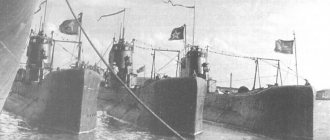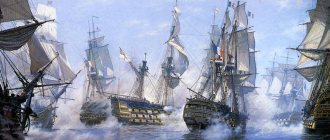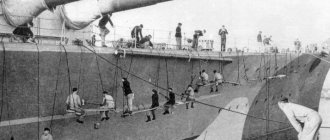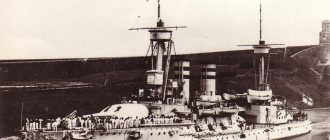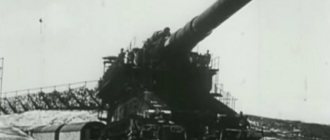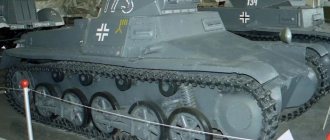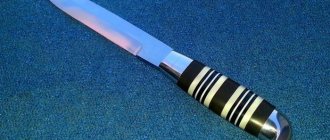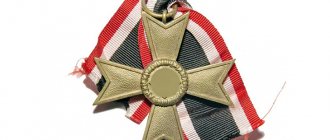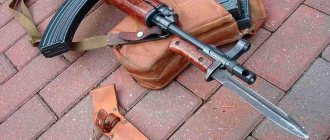September 1939 was the beginning of a successful and long hunt for German submarines. For several years, England sometimes lost more ships (primarily transport ships) to their torpedoes than its shipyards could build. At the very beginning of the great confrontation in the ocean, which went down in history as the “Battle of the Atlantic,” military fortune was on the side of the underwater hunters from the Kriegsmarine... After the war, Winston Churchill admitted on the pages of his book “The Second World War” that it was German submarines, and not the Luftwaffe aces, were the main threat to Great Britain.
Despite the impressive achievements of submarines (especially German ones) in the First World War, after its end, in the eyes of many military experts, submarines continued to remain just an auxiliary means of combat at sea. Few experts believed then that small underwater vessels with imperfect weapons and a limited range could seriously compete with the mighty battleships. However, the chilling Hollywood film stories about bearded pirates from the depths of the sea instilled a lot of fear in the general public. For many, the memories of the scuttling of the passenger liner Lusitania on May 7, 1915 and its 1,198 dead passengers were still fresh. The attacking submarine U-20 was commanded by Captain Walter Schwieger.
The situation began to change by the beginning of the 30s of the 20th century as the design of submarines improved. Japan, in particular, has achieved considerable success in this area. On the eve of World War II, very interesting ships appeared in its imperial fleet: for example, a submarine, on the deck of which there was a reconnaissance seaplane in a closed hangar. By the way, before the attack on the American naval base of Pearl Harbor, it was repeatedly photographed from the air by similar “underwater” seaplanes. The Japanese also actively worked on the creation of ultra-small boats: already in the mid-30s they built the first such boat - officially for underwater research. Five of these boats took part in the famous attack on a US Pacific naval base.
As for Germany, the revival of its power in this area was largely prevented by the Treaty of Versailles in 1919. According to its terms, the Germans were strictly forbidden to have a submarine fleet, but its secret construction never stopped. The Reichswehr and the navy placed their military orders on the territory of friendly countries. For example, tanks and combat aircraft were actively designed and built on the territory of the USSR, and German pilots and tank crews were trained in Lipetsk and Kazan. In Germany itself, when scandalous information leaked to the press, noisy proceedings were organized. Thus, in 1927, as a result of a parliamentary investigation related to information about the construction of Kriegsmarine submarines at Turkish shipyards controlled by Krupp, the head of the naval command, Hans Adolf Zenker, was forced to resign.
In the mid-30s, the British government began to actively look for ways to establish a civilized dialogue with the Hitler regime, considering it as a natural counterbalance to the growing USSR. One of the first actions of the policy of “appeasement” was the signing of the Anglo-German Naval Agreement in 1935. Under this treaty, Germany received the right to begin large-scale construction of a fleet, the total displacement of which should not exceed 35% of the British one. This ratio applied to all classes of ships, except submarines, for which a 45 percent limit was separately specified. In terms of displacement, this was expressed in a rather modest 24 thousand tons. However, the Germans quickly found a way to achieve maximum results in building up their submarine forces without violating the terms of the agreement. And here we must pay tribute to the then leadership of the German fleet, which listened to the opinion of its own experts. When choosing a promising type of submarine, the Germans managed to avoid the belief, quite widespread at that time, that a submarine must necessarily be a large ship - after all, the combat power of a submarine does not increase in direct proportion to its size, like other warships. On the contrary, if you exceed a certain tonnage limit, then the combat qualities of the submarine deteriorate: the immersion time that the boat needs in order to go from the surface to a safe depth increases, and there is a tendency to increase the trim on the bow, that is, a spontaneous tilt of the hull and go into depth. Therefore, instead of large submarines with a displacement of 2,000 tons, it was decided to build four 500-ton submarines. The core of the submarine fleet of the Third Reich was supposed to be boats of the VII series - with four bow and one stern torpedo tubes, a surface speed of 16 knots, and a cruising range of 6,200 nautical miles. By the beginning of the war, 10 such ships were launched.
In December 1938, Germany notified the British government that it would maintain a submarine fleet equal to the British one. And on April 28, 1939, Hitler announced in the Reichstag the termination of the Anglo-German Naval Agreement. By this time, the fascist fleet already had 46 submarines of various classes on the move, and another 11 submarines were laid down on the stocks. 22 submarines were prepared for combat operations in the Atlantic.
On August 19, 1939, 39 submarines reached positions off the northeast coast of England. However, later (during the first period of the war) no more than 7 submarines were on duty in this region.
The Nation's Favorite
The Third Reich knew how to create idols. One of these poster idols created by propaganda was, of course, the hero-submariner Gunther Prien. He had an ideal biography of a guy from the people who made a career thanks to the new government. At the age of 15, he hired himself as a cabin boy on a merchant ship. He achieved the captain's diploma solely thanks to his hard work and natural intelligence. During the Great Depression, Prien found himself unemployed. After the Nazis came to power, the young man voluntarily joined the resurgent Navy as an ordinary sailor and quite quickly managed to show his best side. Then there were studies at a privileged school for submariners and the war in Spain, in which Prin participated as a submarine captain. In the first months of World War II, he immediately managed to achieve good results, sinking several British and French ships in the Bay of Biscay, for which he was awarded the Iron Cross 2nd class from the commander of the naval forces, Admiral Erich Raeder. And then there was a fantastically daring attack on the largest English battleship, Royal Oak, at the main British naval base at Scapa Flow. For the accomplished feat, the Fuhrer awarded the entire crew of U-47 the Iron Cross, 2nd degree, and the commander himself was honored to receive the Knight's Cross from Hitler's hands. However, according to the recollections of people who knew him at that time, fame did not spoil Prin. In his interactions with his subordinates and acquaintances, he remained the same caring commander and charming guy. For just over a year, the underwater ace continued to create his own legend: cheerful reports about the exploits of U-47 appeared almost weekly in film releases of Dr. Goebbels’ favorite brainchild, “Die Deutsche Wochenchau.” Ordinary Germans really had something to admire: in June 1940, German boats sank 140 ships from Allied convoys in the Atlantic with a total displacement of 585,496 tons, of which about 10% were Prien and his crew! And then suddenly everything became quiet at once, as if there was no hero. For quite a long time, official sources reported nothing at all about Germany’s most famous submariner, but it was impossible to hush up the truth: on May 23, 1941, the Navy command officially acknowledged the loss of U-47. She was sunk on March 7, 1941, on the approach to Iceland by the British destroyer Wolverine. The submarine, waiting for the convoy, surfaced next to the guard destroyer and was immediately attacked by it. Having received minor damage, U-47 lay down on the ground, hoping to lie down and leave unnoticed, but due to damage to the propeller, the boat, trying to swim, created a terrible noise, upon hearing which the Wolverine hydroacoustics initiated a second attack, as a result of which the submarine was finally sunk, bombarded with depth charges . However, the most incredible rumors about Prin and his sailors continued to spread in the Reich for a long time. In particular, they said that he did not die at all, but that he had started a riot on his boat, for which he ended up either in a penal battalion on the Eastern Front, or in a concentration camp.
First blood
The first casualty of a submarine in World War II is considered to be the British passenger liner Athenia, which was torpedoed on September 3, 1939, 200 miles from the Hebrides.
As a result of the U-30 attack, 128 crew members and passengers of the liner, including many children, were killed. And yet, for the sake of objectivity, it is worth admitting that this barbaric episode was not very typical for the first months of the war. At the initial stage, many German submarine commanders tried to comply with the terms of the 1936 London Protocol on the rules of submarine warfare: first, on the surface, stop a merchant ship and put an inspection team on board for a search. If, according to the terms of the prize law (a set of international legal norms regulating the seizure by warring countries of merchant ships and cargo at sea), the sinking of a ship was allowed due to its obvious belonging to the enemy fleet, then the submarine crew waited until the sailors from the transport transferred to lifeboats and retreated to a safe distance from the doomed ship. However, very soon the warring parties stopped playing gentlemanly: submarine commanders began to report that single ships they encountered were actively using artillery guns installed on their decks or immediately broadcast a special signal about the detection of a submarine - SSS. And the Germans themselves were less and less eager to engage in politeness with the enemy, trying to quickly end the war that had begun favorably for them.
Great success was achieved on September 17, 1939 by the boat U-29 (Captain Shuchard), which attacked the aircraft carrier Coreys with a three-torpedo salvo. For the English Admiralty, the loss of a ship of this class and 500 crew members was a big blow. So the debut of German submarines as a whole turned out to be very impressive, but it could have become even more painful for the enemy if not for the constant failures in the use of torpedoes with magnetic fuses. By the way, almost all participants experienced technical problems at the initial stage of the war.
Breakthrough at Scapa Flow
If the loss of an aircraft carrier in the first month of the war was a very sensitive blow for the British, then the event that occurred on the night of October 13-14, 1939 was already a knockdown.
The planning of the operation was personally led by Admiral Karl Doenitz. At first glance, the Royal Navy anchorage at Scapa Flow seemed completely inaccessible, at least from the sea. There were strong and treacherous currents here. And the approaches to the base were guarded around the clock by patrolmen, covered with special anti-submarine nets, boom barriers, and sunken ships. Nevertheless, thanks to detailed aerial photographs of the area and data received from other submarines, the Germans still managed to find one loophole. The responsible mission was entrusted to the U-47 boat and its successful commander Gunter Prien. On the night of October 14, this boat, having passed a narrow strait, sneaked through a boom that was accidentally left open and thus ended up in the main roadstead of the enemy base. Prien made two surface torpedo attacks on two English ships at anchor. The battleship Royal Oak, a modernized 27,500-ton World War I veteran, suffered a massive explosion and sank with 833 crew, also killing Admiral Blangrove on board. The British were taken by surprise, they decided that the base was being attacked by German bombers, and opened fire in the air, so that U-47 safely escaped retaliation. Returning to Germany, Prien was greeted as a hero and awarded the Knight's Cross with Oak Leaves. His personal emblem "Bull of Scapa Flow" after his death became the emblem of the 7th Flotilla.
The submarine U-47 under the command of Gunther Prien sank a dozen ships in the Atlantic in June 1940 alone.
Fifth stage. From June 1944 to May 1945
This stage can be called in one word - “defeat”. The Allies completely dominate transatlantic communications. Germany lost its bases in France, the losses of Allied ships were minimal, and the losses of German submariners were catastrophic. Against them are planes with radars, planes from escort aircraft carriers, submarine-hunting ships with advanced asdic sonars capable of detecting a boat even at great depths.
German submarines are destroyed both at bases and when trying to go to sea - they now have to go a long way to the Atlantic, and even under the gun of aircraft armed with radars.
The Allied forces are beating Germany on the ground, in the air, and in the Atlantic. This is the end of the Third Reich.
Capitulated German submarines in front of the gates of the Dora bunker in Trondheim. May 1945. Photo: ru.wikipedia.org
By the end of the war, Germany had excellent developments of both the Me-262 jet aircraft and the new Type XXI submarines, which had a much greater diving depth, much greater speed and much less noise. But it was already too late. A war on two fronts led Germany to defeat for the second time.
Tags: Atlantic Ocean, World War II
Papa Karl's wolf packs
The period of 1940-1941, when the Germans, at the cost of relatively small losses, achieved amazing successes in submarine warfare, they later called the “fat years.”
German submarines went to sea one after another, reducing their path to the Atlantic to a minimum, since after the capture of France their main bases were located on the Atlantic coast - in close proximity to the enemy’s communications. The tonnage of sunk Allied ships began to grow rapidly. Every month the British were losing about 400,000 tons of merchant fleet, which put Great Britain in an extremely difficult situation. The country began to experience a shortage of food and strategic materials. At some point, it even seemed to the main Nazi ideologist of total submarine warfare that his submarines would very soon bring the proud British to their knees. The commander of the Reich submarine fleet, Admiral Doenitz, had the opportunity, managing everything from his Paris headquarters, to fully put into practice the “wolf pack” tactics he had developed back in 1938. Usually everything happened like this: having approximate information about the route of the convoy, a group of submarines numbering 6-9 units fanned out along its path. The commander who was the first to notice the prey immediately broadcast an encrypted message and waited for the rest of the hunters to catch up. And then the “feast” began. Single ships were destroyed immediately, groups were attacked around the clock. The first swarm attack (Rudeltaktik) was carried out in mid-October 1939 by a force of five boats. They managed to sink 3 ships, while losing 2 submarines. As soon as the British established effective coastal patrols by aircraft, the “wolf packs” immediately moved further into the ocean - beyond 19 degrees west longitude. There, far from the British shores, no one stopped German submariners from sinking ship after ship, sometimes chasing their victims for weeks. The British tried to somehow cover their ships in the dead zone, inaccessible to coastal aviation - in the center of the ocean, for this purpose, they even hastily converted the merchant ship Odesity into an escort aircraft carrier with six combat aircraft on board. But in December 1941, the Odesity was sunk, and the mournful list of victims of the “wolf packs” began to grow rapidly again. In 1941, 4,398 ships with a total displacement of 2,100,000 tons were sunk and 35 German boats were lost.
Loyal Leo
The successes achieved during World War II owe much to the German submarine fleet to Karl Doenitz. Himself a former submarine commander, he perfectly understood the needs of his subordinates. The admiral personally greeted each boat returning from a combat cruise, organized special sanatoriums for crews exhausted from months at sea, and attended the graduations of the submariner school. The sailors called their commander “Papa Karl” or “Lion” behind his back. In fact, Doenitz was the engine behind the revival of the Third Reich's submarine fleet. Shortly after the signing of the Anglo-German Agreement, which lifted the restrictions of the Treaty of Versailles, he was appointed by Hitler as “Führer of U-boats” and led the 1st U-boat Flotilla. In his new position, he had to face active opposition from supporters of large ships from the Navy leadership. However, the talent of a brilliant administrator and political strategist always allowed the submariner chief to lobby the interests of his department in the highest government spheres. Dönitz was one of the few convinced National Socialists among senior naval officers. The admiral used every opportunity presented to him to publicly praise the Fuhrer. Once, speaking to Berliners, he became so carried away that he began to assure his listeners that Hitler foresaw a great future for Germany and therefore could not be wrong: “We are worms compared to him!” In the first war years, when the actions of his submariners were extremely successful, Doenitz enjoyed Hitler's complete confidence. And soon his finest hour came. This takeoff was preceded by very tragic events for the German fleet. By the middle of the war, the pride of the German fleet - heavy ships of the Tirpitz and Scharnhost type - were actually neutralized by the enemy. The situation required a radical change in the guidelines in the war at sea: the “battleship party” was to be replaced by a new team professing the philosophy of large-scale underwater warfare. Following the resignation of Erich Raeder on January 30, 1943, Dönitz was appointed his successor as Commander-in-Chief of the German Navy with the rank of Grand Admiral. And two months later, German submariners achieved record results by sending 120 Allied ships with a total tonnage of 623,000 tons to the bottom during March, for which their chief was awarded the Knight's Cross with Oak Leaves. However, the period of great victories was coming to an end. Already in May 1943, Doenitz was forced to withdraw his boats from the Atlantic, fearing that he would soon have nothing to command. (By the end of this month, the Grand Admiral could draw terrible results for himself: 41 boats and more than 1,000 submariners were lost, among whom was Doenitz’s youngest son, Peter.) This decision infuriated Hitler, and he demanded that Doenitz cancel the order , while declaring: “There can be no question of ending the participation of submarines in the war. The Atlantic is my first line of defense in the west." By the fall of 1943, for every Allied ship sunk, the Germans had to pay with one of their own boats. In the last months of the war, the admiral was forced to send his people to almost certain death. And yet he remained faithful to his Fuhrer to the very end. Before committing suicide, Hitler appointed Doenitz as his successor. On May 23, 1945, the new head of state was captured by the Allies. At the Nuremberg trials, the organizer of the German submarine fleet managed to avoid responsibility on charges of giving orders, according to which his subordinates shot sailors who escaped from torpedoed ships. The admiral received his ten-year sentence for carrying out Hitler’s order, according to which captured crews of English torpedo boats were handed over to the SS for execution. After his release from West Berlin Spandau prison in October 1956, Doenitz began writing his memoirs. The admiral died in December 1980 at the age of 90. According to the testimony of people who knew him closely, he always kept with him a folder with letters from officers of the Allied navies, in which former opponents expressed their respect for him.
U-505 – a symbol of inevitable defeat
From Bermuda, classified materials were sent to Washington. Among them were maps, thanks to which Allied intelligence could find out the exact location of Kriegsmarine boats in the Atlantic. U-505 became a symbol of the imminent defeat of the submarine fleet of the Third Reich.
U - 505 / Photo by Jeremy Atherton from the Chicago Museum
Drown everyone!
“It is prohibited to make any attempts to rescue the crews of sunken ships and vessels, transfer them to lifeboats, return overturned boats to their normal position, or supply the victims with provisions and water.
Rescue contradicts the very first rule of warfare at sea, which requires the destruction of enemy ships and their crews,” the commanders of German submarines received this order from Doenitz on September 17, 1942. Later, the Grand Admiral motivated this decision by the fact that any generosity shown to the enemy costs his people too dearly. He referred to the Laconia incident, which occurred five days before the order was issued, that is, on September 12. Having sunk this English transport, the commander of the German submarine U-156 raised the Red Cross flag on his bridge and began rescuing the sailors in the water. From the board of U-156, on an international wave, a message was broadcast several times that the German submarine was conducting rescue operations and guaranteeing complete safety to any ship ready to take on board sailors from the sunken steamer. Nevertheless, after some time, U-156 attacked the American Liberator. Then air attacks began to follow one after another. The boat miraculously escaped destruction. Hot on the heels of this incident, the German submarine command developed extremely strict instructions, the essence of which can be expressed in a laconic order: “Do not take prisoners!” However, it cannot be argued that it was after this incident that the Germans were forced to “take off their white gloves” - cruelty and even atrocities have long become commonplace in this war. Since January 1942, German submarines began to be supplied with fuel and supplies from special cargo underwater tankers, the so-called “cash cows,” which, among other things, housed a repair crew and a naval hospital. This made it possible to move active hostilities to the very coast of the United States. The Americans turned out to be completely unprepared for the fact that the war would come to their shores: for almost six months, Hitler’s underwater aces hunted with impunity for single ships in the coastal zone, shooting at brightly lit cities and factories with artillery guns in the dark. Here’s what one American intellectual, whose house overlooked the ocean, wrote about this: “The view of the boundless sea space, which used to inspire life and creativity so much, now makes me sad and terrified. Fear permeates me especially strongly at night, when it is impossible to think about anything else except about these calculating Germans, choosing where to send a shell or torpedo ... "
Only by the summer of 1942, the US Air Force and Navy managed to jointly organize reliable defense of their coast: now dozens of aircraft, ships, airships and private speed boats were constantly monitoring the enemy. The US 10th Fleet organized special "killer groups", each of which included a small aircraft carrier equipped with attack aircraft and several destroyers. Patrolling by long-range aircraft equipped with radars capable of detecting the antennas and snorkels of submarines, as well as the use of new destroyers and ship-borne Hedgehog bombers with powerful depth charges, changed the balance of forces.
In 1942, German submarines began to appear in polar waters off the coast of the USSR. With their active participation, the Murmansk convoy PQ-17 was destroyed. Of his 36 transports, 23 were lost, while 16 were sunk by submarines. And on April 30, 1942, the submarine U-456 hit the English cruiser Edinburgh with two torpedoes, sailing from Murmansk to England with several tons of Russian gold to pay for supplies under Lend-Lease. The cargo lay at the bottom for 40 years and was lifted only in the 80s.
Submarine U-453 with enhanced anti-aircraft weapons. Sunk on 21 May 1944 off the island of Sicily
Fourth stage. From April 1943 to June 1944
The Allies go on the offensive. Heavy bombers with radar detect German U-boats in the night and through the clouds and drop bombs on them using radar bomb sights. The British widely use the interceptions of German submarine radiograms they deciphered to protect convoys and to attack German “hunters.”
Allied ship losses are still high, but they have already fallen to 26%, and the losses of German submarines and their crews are continuously growing. It’s already reached the point that only the middle of the Atlantic remains without allied air cover, and therefore the first hundreds of kilometers from their bases, submarines pass in kind of convoys under the anti-aircraft cover of special non-diving submarines, equipped with a large number of anti-aircraft guns, whose role when detecting attacking aircraft is not to leave under water, and fight with aircraft attacking the submarine convoy.
The crew of the German submarine U-664 leaves the sinking submarine, 08/09/1943. Photo: Source
The British deciphered the Enigma codes, and now every submarine broadcast in the Atlantic is information for squadrons of submarine hunters.
Radars on airplanes made it possible to see German submarines at night, under clouds, and in fog. See and bomb accurately.
In the Battle of the Atlantic, the best crews died, and instead of them, crews without combat experience went into battle. It was easier for the Western allies to destroy such submarines than the submarines crewed by experts who went into battle at the beginning of the battle.
When submarines attacked convoys, hunter ships equipped with depth charges and sonar began to hunt for them - they could see submarines deep underwater.
Wolf Hunt
By the end of 1944, the Germans had already completely lost the Battle of the Atlantic.
Even the newest boats of the XXI series, equipped with a snorkel - a device that allows you not to surface for a significant period of time to recharge batteries, remove exhaust gases and replenish oxygen reserves, could no longer change anything (the snorkel was also used on submarines of earlier series, but not very successfully). The Germans only managed to make two such boats, with a speed of 18 knots and diving to a depth of 260 m, and while they were on combat duty, World War II ended. Countless Allied aircraft, equipped with radar, were constantly on duty in the Bay of Biscay, which became a veritable graveyard for German submarines leaving their French bases. Shelters made of reinforced concrete, having become vulnerable after the British developed the 5-ton concrete-piercing Tallboy aerial bombs, turned into traps for submarines, from which only a few managed to escape. In the ocean, submarine crews were often pursued for days by air and sea hunters. Now the “Dönitz wolves” were getting less and less a chance to attack well-protected convoys and were increasingly concerned about the problem of their own survival under the maddening pulses of search sonars, methodically “probing” the water column. Often, the Anglo-American destroyers did not have enough victims, and they attacked any discovered submarine with a pack of hounds, literally bombarding it with depth charges. Such, for example, was the fate of U-546, which was simultaneously bombed by eight American destroyers! Until recently, the formidable German submarine fleet was not saved by either advanced radars or enhanced armor, nor did new homing acoustic torpedoes or anti-aircraft weapons help. The situation was further aggravated by the fact that the enemy had long been able to read German codes. But until the very end of the war, the German command was completely confident that the codes of the Enigma encryption machine were impossible to crack! Nevertheless, the British, having received the first sample of this machine from the Poles in 1939, by the middle of the war created an effective system for deciphering enemy messages under the code name “Ultra,” using, among other things, the world’s first electronic computer, “Colossus.” And the British received the most important “gift” on May 8, 1941, when they captured the German submarine U-111 - they got into their hands not only a working machine, but also the entire set of hidden communications documents. From that time on, for German submariners, going on the air for the purpose of transmitting data was often tantamount to a death sentence. Apparently, Doenitz guessed about this at the end of the war, since he once wrote in his diary lines full of helpless despair: “The enemy holds a trump card, covers all areas with the help of long-range aviation and uses detection methods for which we are not ready. The enemy knows all our secrets, but we know nothing about their secrets!”
According to official German statistics, out of 40 thousand German submariners, about 32 thousand people died. That is, many more than every second! After Germany's surrender, most of the submarines captured by the Allies were sunk during Operation Mortal Fire.
Source: “Around the World”, author: Anton Krotkov. Illustrations by Mikhail Dmitriev
Third stage. From December 1941 to March 1943
Both Japan and the United States entered the World War. In an all-out submarine war, Germany has abandoned any restrictions, Allied losses are approaching critical, and the Allies are bringing more and more technical innovations to the battle in the Atlantic.
At the beginning of this stage, wolf packs of German submarines thrown into battle in the Atlantic greatly hindered the implementation of the plans of the Western Allies. In 1942, 323 ships were lost during transportation across the Atlantic, or 47% of all Allied ship losses during the war with Germany.
Aerial view of a British convoy in the Atlantic Ocean Photo: Source
Germany abandoned the use of surface raiders in the battle with the United States and England, but underwater raiders made it extremely difficult to deliver weapons, ammunition and ammunition from America. The Allies developed a technique for combating Doenitz wolf packs and began to apply it. This application of new Allied developments marked a new stage in the Battle of the Atlantic.
